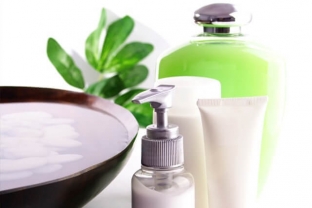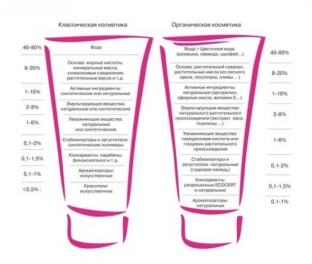Choice of cosmetics and care products – the task is not easy. The market is saturated with beauty products, whose manufacturers promise high efficiency and safety of their products for buyers. Wanting to emphasize the harmlessness of cosmetics and increase consumer interest in them, manufacturers often use the prefixes "eco"; and "bio". In such a variety of inscriptions on cosmetic products – "eco", "bio", "organic", "natural" – it's very easy to get confused. Therefore, estet-portal.com decided to look into this issue and find out how ordinary products differ from ecocosmetics and biocosmetics.
Understanding the terms: what is organic and biocosmetics
Standards in force in Europe and America determine whether cosmetics are natural, organic, eco or bio.
We note right away that organic and biocometics – cosmetics, which at least 95% consists of natural raw materials grown without pesticides and other artificial growth stimulants in ecologically clean areas. And if there are ingredients of animal origin in biocosmetics, it is guaranteed that they were obtained without violence against animals.

These cosmetics meet the standards for the production of organic cosmetics:
- It is forbidden to use refined petroleum products;
- It is forbidden to use synthetic dyes, fragrances and other substances;
- GMOs are prohibited;
- Testing on animals is prohibited;
- It is forbidden to use substances obtained from dead animals;
- it is allowed to use substances that are naturally excreted by animals (honey, milk, beeswax, etc.);
- it is forbidden to process ingredients with ionizing radiation, etc.
In order to obtain the appropriate "bio" labeling, in Western countries, the product must pass the certification procedure in an authorized organization.
In order to obtain the appropriate "bio" labeling, in Western countries, the product must pass the certification procedure in an authorized organization. Accordingly, there are general principles that apply to all certifying organizations, however, the severity of their requirements may vary, including for:
- minimum content of organic ingredients (in %);
- maximum permitted content of synthetic ingredients (in %);
- permitted and prohibited ingredients;
- permitted and prohibited methods of processing ingredients;
It is also worth noting that water is not an organic component of cosmetics, therefore the percentage of organic ingredients for rinse-off and leave-in products is different (since there is more water in rinse-off products, the content of organic components in them is lower).
Examples of marks applied to organic and biocosmetics in different countries:

What is the difference between organic and biocosmetics and eco and natural cosmetics?
Ecocosmetics differ from conventional ones in that during their production, transportation, use and storage, the risks of damage to the environment are minimized. In other words, the label "eco" may mean that such a product causes less harm to the environment. However, not always "eco" means the naturalness and usefulness of cosmetics for humans.
It is worth noting that natural cosmetics – another concept that misleads the buyer. When buying natural products, we expect to see a large percentage of natural ingredients in it. In fact, this is not so. In fact, any remedy that contains at least one natural component can be called natural, while its percentage is not regulated, i.e. cosmetics marked "natural" – mixture of natural and synthetic ingredients. Therefore, it is worth learning to read the composition of cosmetics.

Organic and biocosmetics contain 95% natural ingredients grown without pesticides and other artificial growth stimulants in ecologically clean areas.
Thus, it is better to choose care products related to organic, bio- or eco-cosmetics. However, remember that even natural ingredients can cause individual allergic reactions, therefore, before using any cosmetic product, it is necessary to test it. To do this, apply a small amount of the product to the inner bend of the elbow. If redness, rash, peeling, itching and other undesirable reactions do not appear on the skin during the day, this remedy is suitable for you.
See also: What substances in cosmetics can harm the skin?
Estet-portal.com also warns that the prefixes "eco", "bio", "organic" by themselves, not supported by the appropriate certificates, cannot guarantee the safety and naturalness of the selected product. Therefore, carefully read the composition of cosmetics, remember that high-quality natural cosmetics cannot be cheap, and do not hesitate to ask the seller about the availability of the necessary confirmation certificates.






Add a comment